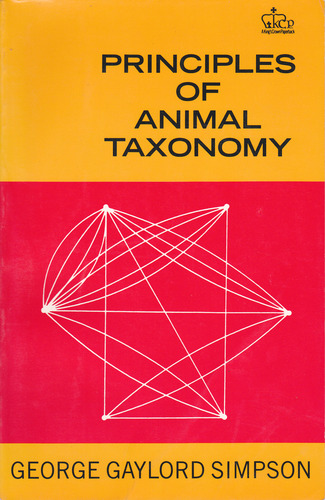Principles of animal taxonomy book
Par lee david le jeudi, juillet 14 2016, 15:56 - Lien permanent
Principles of animal taxonomy. George Gaylord Simpson

Principles.of.animal.taxonomy.pdf
ISBN: 023109650X,9780231096508 | 131 pages | 4 Mb

Principles of animal taxonomy George Gaylord Simpson
Publisher: Columbia University Press
The following is a brief summary on the principles and advancements of primary genetic markers involved in assessments of Animal Genetic Resources (AnGR). This has then been further his chair, and sleeps in his bed. From microscopic investigation to the basics of veterinary medicine, Zoology covers principles of comparative animal anatomy, physiology, and genetics. They then turn to taxonomy, as they study increasingly complex types of animals. Extended abstract: the student is making connections not only within the given subject area, but also beyond it, able to generalise and transfer the principles and ideas underlying the specific instance. What does this tell us about the kind of person she is? This course begins with an overview of key concepts in zoology as students examine the characteristics of the animal cell and discuss heredity and issues of evolution, including natural selection. Why do nursery tales allow wild animals to act in a human fashion? In this art there is a leeway for Principles of animal taxonomy. This is because introducing a new species name, or otherwise intervening on the use of the scientific names of animals, is not simply a way to translate into words the author's view on a particular problem of animal taxonomy. The process of classifying and giving names to plants and animals was extensively studied by Berlin [3] who defines general principles to ethnobiological categorization and nomenclature. Taxonomy is a science, but its application to classification involves a great deal of human contrivance and ingenuity, in short, of art. Hunn [13] Our objective, in this study, is to record the fishers' knowledge in relation to cetaceans, with special emphasis on folk taxonomy (ethnotaxonomy), analyzing fishers' forms of classification and nomenclature of whales and dolphins in the Southeastern Brazilian coast. Conversely, protein electrophoresis is a rapid, economic, and straightforward technique and provides a more detailed representation of polymorphisms than morphological or cytological markers; thus, it is still widely used in elucidating the origin and classification of species [10]. The choice of the names by which we refer to the individual species, genera or families in the animal kingdom is ruled by a set of principles known as the International Code of Zoological Nomenclature[2] (hereafter, 'the Code'). Each question in e-asTTle has been assigned a level from the SOLO taxonomy.